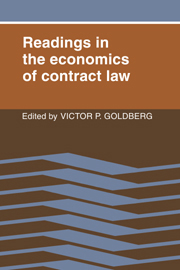Book contents
- Frontmatter
- Contents
- Preface
- Readings in the economics of contract law
- Part I Some preliminaries
- Part II Contract law and the least cost avoider
- Part III The expectation interest, the reliance interest, and consequential damages
- Part IV The lost-volume seller puzzle
- Part V Specific performance and the cost of completion
- 5.1 The choice of remedy for breach of contract
- 5.2 Relational exchange, contract law, and the Boomer problem (2)
- 5.3 Cost of completion or diminution in market value: the relevance of subjective value
- Questions and notes on specific performance and cost of completion
- Part VI Power, governance, and the penalty clause puzzle
- Part VII Standard forms and warranties
- Part VIII Duress, preexisting duty, and good faith modification
- Part IX Impossibility, related doctrines, and price adjustment
- Questions and notes on impossibility and price adjustment
- References
- Index of cases
- Author index
- Subject index
5.2 - Relational exchange, contract law, and the Boomer problem (2)
Published online by Cambridge University Press: 10 November 2010
- Frontmatter
- Contents
- Preface
- Readings in the economics of contract law
- Part I Some preliminaries
- Part II Contract law and the least cost avoider
- Part III The expectation interest, the reliance interest, and consequential damages
- Part IV The lost-volume seller puzzle
- Part V Specific performance and the cost of completion
- 5.1 The choice of remedy for breach of contract
- 5.2 Relational exchange, contract law, and the Boomer problem (2)
- 5.3 Cost of completion or diminution in market value: the relevance of subjective value
- Questions and notes on specific performance and cost of completion
- Part VI Power, governance, and the penalty clause puzzle
- Part VII Standard forms and warranties
- Part VIII Duress, preexisting duty, and good faith modification
- Part IX Impossibility, related doctrines, and price adjustment
- Questions and notes on impossibility and price adjustment
- References
- Index of cases
- Author index
- Subject index
Summary
The specific performance remedy provides … [an] illustration [of the Boomer problem]. Confining a buyer to a court-determined measure of damages short-circuits the market mechanism preventing the buyer from registering his true preferences. On the other hand, if after a seller's breach, performance is expensive and is of little value to the buyer, granting the buyer an injunction would result in “economic waste.” The waste will not, except by accident, entail actual performance of the obligation. Rather, as in Boomer, it would entail excessive rent seeking by the two parties.
Suppose that the costs that a buyer would incur if the contract were breached exceeded the damages that he could collect. In that case the seller would have an incentive to use the threat of termination to redefine the contract on more favorable terms. The buyer can be shielded from this threat by granting him specific performance so that the seller could not legally carry out his threat. This is very similar to allowing the buyer to invoke duress to disallow the contract modification that the threat produced. In both cases, the costs of rent seeking are avoided.
But avoidance of these costs itself involves costs. It encourages buyers to get into such situations in the first place. The routine granting of specific performance (just as a policy of liberal acceptance of the duress excuse or routine compensation of consequential damages) would in many instances provide perverse incentives to promisees inducing over-reliance on the contract. They could maintain tiny inventories, build machines that require inputs from a single supplier, and so forth, knowing that the specific performance remedy would bail them out.
- Type
- Chapter
- Information
- Readings in the Economics of Contract Law , pp. 126 - 127Publisher: Cambridge University PressPrint publication year: 1982



